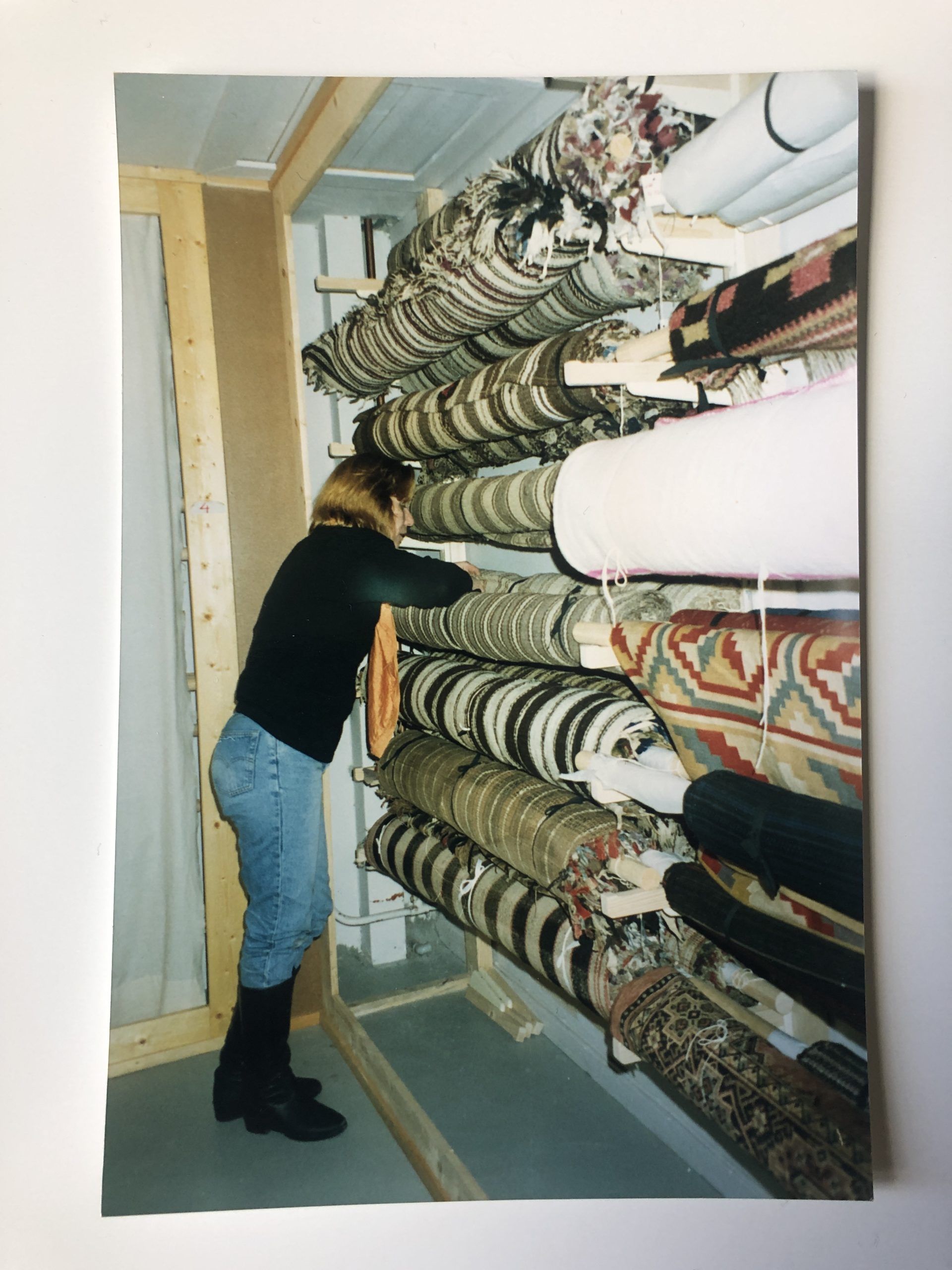
BEAUTY in Capital Letters
Two artworks by Elisabeth Haarr have been acquired for the newly renovated Norwegian embassy in Washington, D.C.
The wall hangings Færdaminne – OH Gunta! (2013) and Færdaminne – Jammerbugt (2013) are part of a series of works titled Færdaminner (Travelogues) (2013-present). Each work is made from waxed tablecloths, to which Haarr has applied paint and sewn textile fragments that hang down like pile from the waxed cloth. The works are large but weigh little. They are suspended a few centimeters away from the wall and can billow slightly if someone walks past them. Apart from these common characteristics, the works vary considerably in color, quality of fabric, and style.
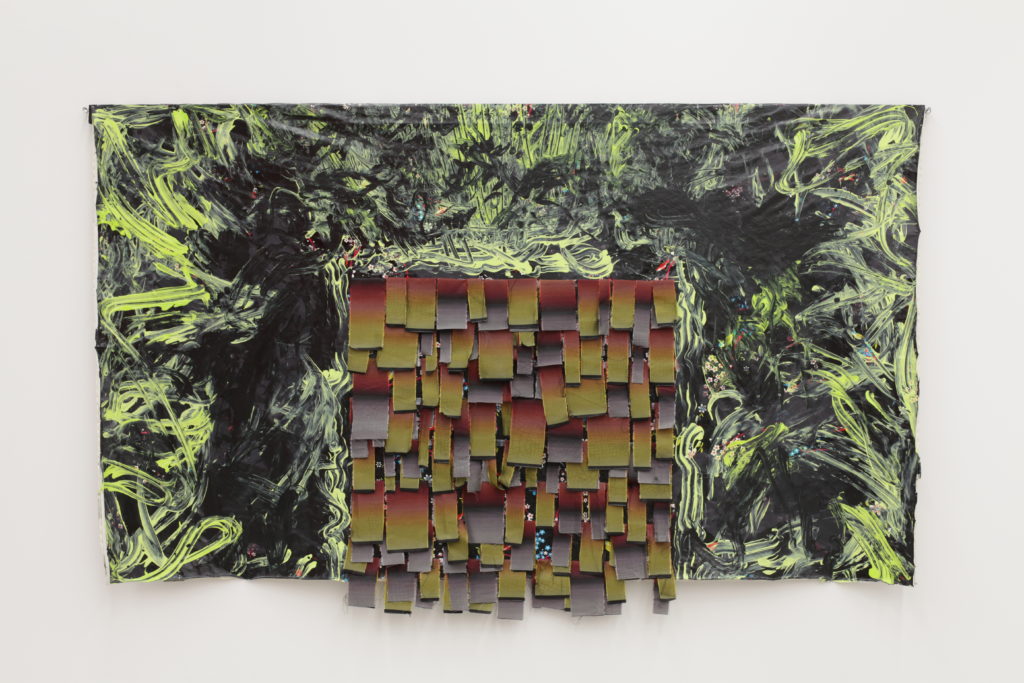
Rya Boat Rugs
An important source of inspiration and reference for the series Færdaminner are the traditional Norwegian rya boat rugs. These rugs are an aspect of Norwegian coastal craft traditions with which Haarr has concerned herself during much of her career:
– I’ve been interested in what kinds of textile production people have been engaged in here in Norway, and I’ve been interested in the lives of women along the coast. Some of our foremothers were incredibly strong and tough. They weren’t delicate flowers sitting indoors with embroidery frames; they were out there in the real world and working hard.
– The rya rugs that have captivated my interest are particularly the ones that were made along the coast, especially for use in boats. People also made rya rugs to have in bed and in sleighs, but they often tended to move back and forth between different uses. One that was made for use on a bed would be used in a sleigh when it got worn. Rya rugs are a type of rug that would be woven by women living along the coast, so that their husbands could keep themselves warm at sea, and they often had them in their trousseaux when they got married. The rugs were woven on looms and consisted of two parts, with a pile on one side, and a pattern that was usually checks or stripes, or a combination of both, on the other. The rug was a sort of artificial sheepskin, hence the pile, but where a real sheepskin would become stiff if you were fishing out at sea in an open boat, the artificial sheepskin, made of wool, would stay soft and keep you warm.
The women that Haarr is referring to were both farmers and housewives, running the homes and farms while their husbands were out at sea fishing. These women wove, knitted, baked bread, took care of the livestock, grew potatoes and other vegetables, and climbed onto the roof themselves if the chimney got blocked.
– Rya boat rugs represent an aesthetic that’s an extension of this lifestyle, and it’s one that interests me because it’s so different to the aesthetic we learned at school and which I experienced as coercion. I thought our handicraft lessons were the worst thing ever. There were so many rules, so many things that weren’t allowed, and I thought the handicraft teachers were the most horrible people. But these rules don’t apply in the world of rya rugs. In that world, there’s beauty of a completely different kind. The rya rugs represent a beauty that’s about life and death, about love and brutal reality.
Towards the end of the 1980s Haarr moved to Trondheim, where, some years later, she met the U.S. textile researcher Amy Lightfoot. Lightfoot was interested in these distinctive rya rugs, and she told the artist that there were treasure troves of rya rugs that few people had seen, stored in small local museums along the west coast of Norway. At the time Haarr was conducting research for an art exhibition she was putting together with her colleague, the painter Solrunn Rones. Their aim was to feature contemporary artists who engaged actively with the history of textiles, and following Lightfoot’s lead, the two traveled to museums in Kristiansund, Ålesund, and Sunnfjord.
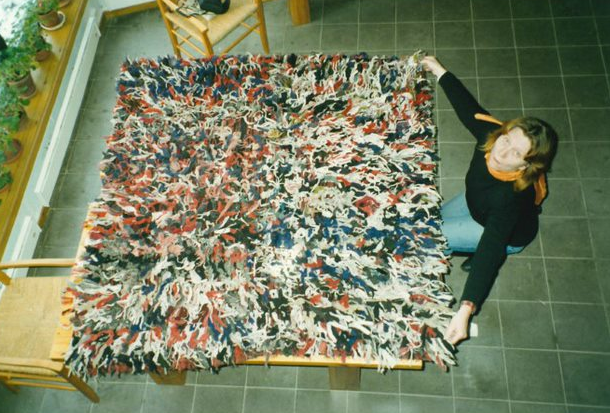
– We got to see a fantastically large number of beautiful old rya rugs. I remember that the conservator at the museum in Ålesund initially was quite skeptical towards us – two artists just showing up at her door – but in the end she was so happy that someone finally showed an interest in the textile collection, that she even let us smoke in the storage room.
– We got so enthusiastic about these rya rugs, and we realized that they had to play the main role in the exhibition we were planning. We got to borrow rya rugs from these museums and we juxtaposed them with works by three contemporary artists: Sissel Calmeyer, Karin Lindell and Kristi Skintveit. The exhibition was shown in several museums between Trondheim and Bergen.
What is it that fascinates you about rya rugs?
– These rugs contain both beauty and brutal reality. Young women would weave these boat rugs to include them in their bridal chests. On one side a woman would work in her own initials or the name of her future husband – the man who would own the rug in the future. The reason for including a name was to make it possible to identify him if he drowned at sea. In other words, rya boat rugs were woven with love, but also with a rational purpose, and in the knowledge that their owners might die. Having a name woven into the rug would allow him to be identified and buried on home ground.
The varied beauty that these rugs represent is based on this rationality. Making one rya rug would consume four years of a smallholding’s average total wool production. The wealthy could afford to splash out on masses of new wool for their rya rugs, and the amount of new wool in a rug tells us something about the financial status of the owner. The poor had to resort to lower quality wool, or supplement it with rags.
– My favorite rya rug was made by Elina Hatlen. It includes a whole wardrobe of women’s clothing, including stockings and underwear, dressmaking fabric and table linens. It’s from Nordfjord and was made around 1850. Fortunately it’s preserved in a museum, but we don’t know much about Elina, who made it. She was either a seamstress or she used the whole of her mother’s wardrobe after her mother had died.
Rya rugs have many similarities to Persian and oriental rugs, but the latter two have visible knots on the reverse, whereas rya rugs are woven in a way that hides the knots inside the weave. Technically this is very advanced, and as a result rya rugs, with their intricate patterns on one side and long pile on the other, do not have a front side and a reverse.
– They were skilled handweavers who knew what they were doing, and they added extra beauty wherever they could. But it’s an aesthetic that represents a different type of beauty than the one we associate with the Victorian style – the skillful and pretty, with sweet little stitches and small, cute embroideries – here we’re speaking in capital letters. I became completely entranced by the aesthetic that rya boat rugs represent.
From Tradition to Textile Art
You have also been intrigued by the role that traditional practices have played in contemporary textile art – a scene you are also a part of.
– Yes, one could say that modern Norwegian textile art – which started with Frida Hansen (1855-1931) – arises directly from the general production of textiles by women along the Norwegian coast.
– Hansen originally made a wealthy marriage, but when her husband went bankrupt, she started a small embroidery business. A traditional wool coverlet (åkle) was brought in for repair, and she found it so fine that she decided to learn to weave. This journey took her to Kjerstina Hauglum, in Sogn, a famous handweaver at that time, in order to study the craft. Hauglum and Hansen used the old warp-weighted loom (opstadvev), a type of loom that had been used along the coast for over a thousand years, and which had always looked more or less the same. It’s quite a primitive loom, but women had nevertheless woven sophisticated coverlets and functional textiles on it. These coverlets look different along the coast with their checks, stripes, and fiery flame stitch patterns.
– A warp-weighted loom has a vertical warp and you can weave in the weft where you want. This contrasts with a low-warp loom, where the warp lies horizontally, and you can sit down to weave with treadles and beater and see the pattern that you are weaving in front of you. Hansen modernized the warp-weighted loom by adding treadles and shanks, making the looms easier to weave on. Based on the old techniques used for coverlets, she developed several advanced techniques that made it possible to create complicated compositions on a warp-weighted loom. Hansen’s important work is the background to what we call billedvev (translated here as “tapestry”) in Norway today.
– You can draw a direct line from everyday traditional handweaving practiced in coastal communities to contemporary Norwegian textile art. As a result, what we in a Norwegian context call tapestry (billedvev) is very different to what is made in the rest of Europe. Gobelin tapestries, for example, are woven in a different manner. There is no one else who makes tapestries as we do in Norway, and thus I believe this to be the backbone of our textile art. The Norwegian art historian Holger Koefoed once called Norwegian tapestry “the pipe organ of visual art.” He may have been right about that.
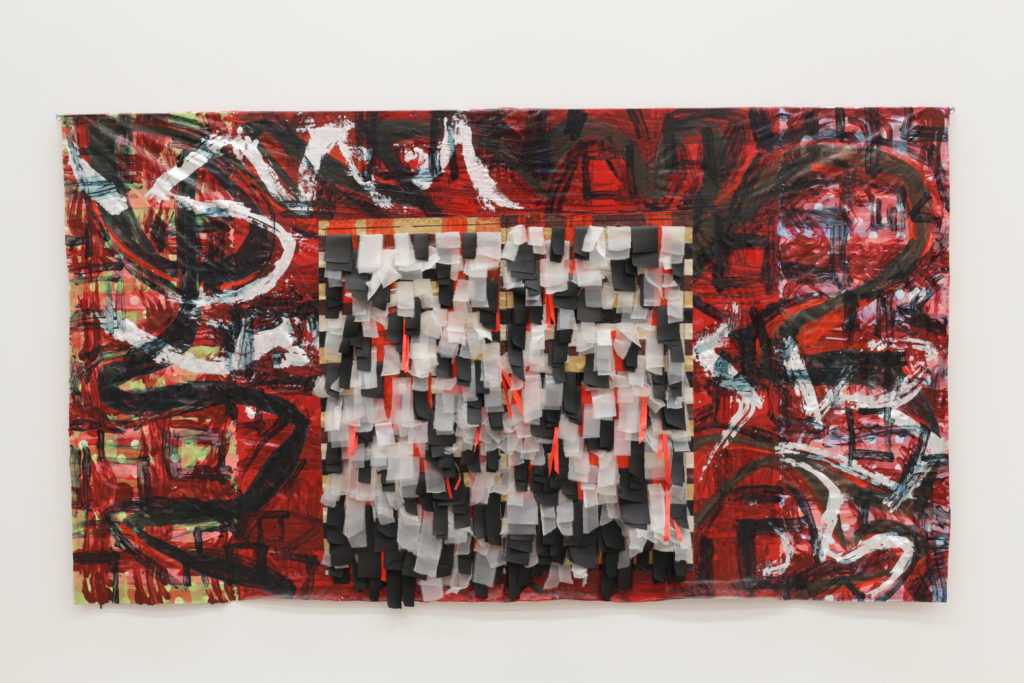
Travelogues
Haarr did not forget the old rya boat rugs that she had discovered in the 1990s, and years later, after moving to Kristiansand on the southern coast of Norway, she decided to create a series of works concerning the idea of traveling. Given that these rugs are precisely about setting out on a journey, it became natural to use them as an element in the stories she wanted to tell. But she had developed problems with her hands, and she couldn’t sew much anymore. The solution was to paint on waxed tablecloths and sew textile fragments onto them. In order to retain contact with the materials she applied the paint directly with her hands.
– Both the works [in Washington] are painted with my hands. I can no longer manage to hold a brush very well, so I paint with my fingers instead. That works fine too: you gain a closer, more physical relationship with the material, much like when working with textiles. You can exploit the physical aspect of painting when you have your hands in the paint. If you look at Jammerbugt for instance, you can see that I have been agitated, it’s painted in an agitated way, with powerful movements.
Haarr has taken the word “Færdaminne” (translated here as “Travelogue”) from the title of Aasmund Olavsson Vinje’s book Ferdaminni frå Sumaren 1860 (Travel Memories from Norway 1860) (1861).
– I wanted to create a series of works that were about my travels, as well as my inner journeys. I’ve moved a lot in my life, and my relationship with landscape is quite strong, as it probably is for most Norwegians – our relationship with the weather, the wind, and all that. In my youth I’d read Ferdaminni by Vinje, and at school we sang “Now I see again the same mountains and valleys.”1 The book is the earliest travel book ever written about Norway, or at least the earliest by a Norwegian, and I remember that I was very moved by it – the fact that he goes back to places he’d been before, and so on. He was a great poet. So I found Færdaminner to be a good umbrella title for the works I was making, but I spelled it with the Norwegian letter Æ, because to spell it in the same way as Vinje had, would suggest that perhaps I was getting above myself. I also added a subtitle to each of the works that refers to what the image is about. The two for the embassy are called OH Gunta! and Jammerbugt.
Turbulent Sea (Jammerbugt)
– My husband and I used to go on camping trips, and we often went to Denmark and camped close to Jammerbugt [“Bay of Misery”], in the northwest of Jutland, a bay where incredibly many ships have sunk. We had been in Tønder to see an exhibition, and while there I saw a painting by a Danish painter called Jens Søndergaard. The painting showed people standing on the beach looking out over the sea, a sea that is gradually ceasing to be turbulent. You can tell from the colors and the sky that the sea is in the process of settling down. There are some people standing on the beach and one person, almost a pale blue, is leaving the beach and coming towards you. That painting made a very strong impression on me. I’ve lived by the sea for many years, and people close to me have lost family members at sea. So I wanted to make a Travelogue about that experience.
– This Travelogue is actually painted on a very cheerful waxed tablecloth, with small birds and flowers. It was black originally, and I painted over it with black and yellow, normally an ugly color combination, and then I allowed some birds and flowers from the pattern on the wax cloth to remain. The pile is made of umbrella fabric, and perhaps I’m the only one who knows or sees it that way, but it’s about the idea of protection. An umbrella protects you from the wet, the pile protects against the wet, and in this lies an idea of caring. A sort of togetherness and empathy, a greeting from me. That’s what I’ve tried to convey. It’s a serious work, and I hope that I relayed the story without needing to tell the whole backstory, which is my own, but that it’s possible to understand that it has something to do with a turbulent sea.
Declarations of Love (OH Gunta!)
On her honeymoon in 2003, Haarr visited the historic art school Bauhaus Dessau. A photograph of her from that trip hangs on a wall in her studio. Newlywed and happy she stands wearing a checked dress in front of Walter Gropius’s grid-like facade, and the grid pattern is also repeated in the sidewalk she’s standing on. Back then, Bauhaus had just recently been added to UNESCO’s World Heritage Site list, and to a large extent the buildings looked as they did when the school was in use.
Among the other visitors and students, Haarr walked the corridors, climbed the worn staircases, and visited the canteen in the basement – taking in the energy of the school. The famous masters’ houses were newly restored, and pensioner volunteers were eager to provide information and excited about people’s interest in the school. Haarr later sewed fabric from the dress she was wearing that day into the work Færdaminne – Dessau (Travelogue – Dessau) (2013), which is thematically closely linked to her work OH Gunta!
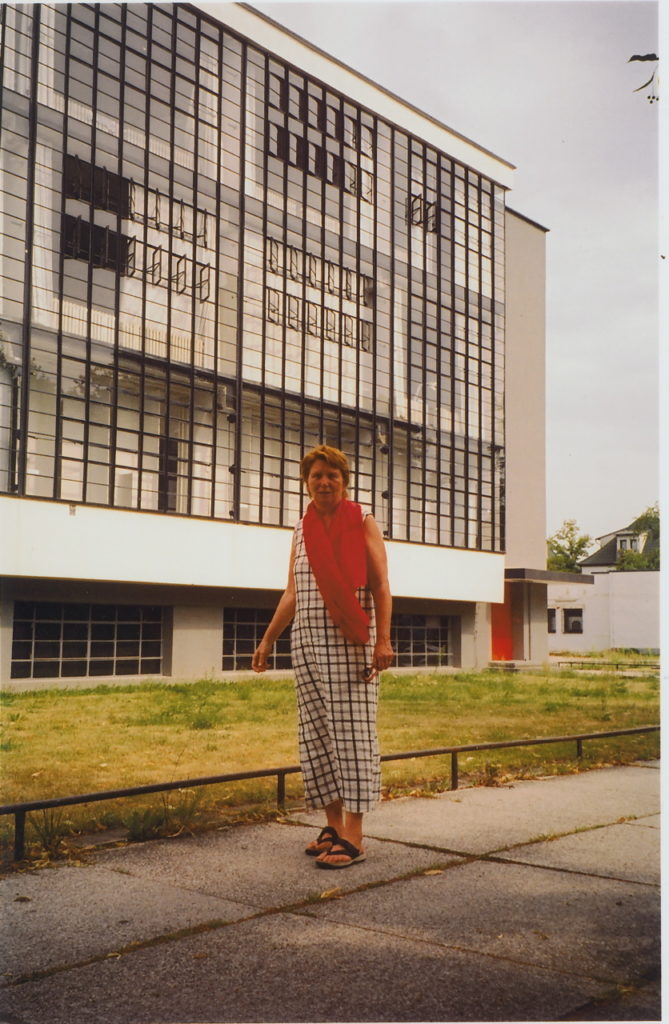
You mentioned earlier that rya boat rugs were in many ways declarations of love to seafaring men. Your work Færdaminne – OH Gunta! is also a declaration of love from you to the Bauhaus master Gunta Stölzl. Can you tell us more about her and your visit to Dessau?
– In one of my Bauhaus books, I’d seen a photograph from 1927 of the textile class standing grinning on a staircase, and there I was inside the school, going up the staircase myself; I was about to swoon! I saw the worn-down steps, and thought that this was where they walked, all those stars. These students who later became so important for the art world went up and down these stairs, this was where they talked and debated. Think of everything that was going on in these rooms and outside them! I thought about all the woven fabrics, and about Paul Klee, who was teaching the textile class, everything he learned from them and everything they learned from him. And then I thought of Gunta Stölzl, whom I admire very much. I can’t call her a role model, but she is an artist I hold in high esteem. So the visit was a powerful experience, particularly seen in light of the school’s history. It was the first institution to be closed by the Nazis. That shows how provocative art can be, even when it is only about making something beautiful for other people and making their life more comfortable.
What is it about Stölzl that causes you to hold her in such high esteem?
– The first work I saw by her was really a sample, a tapestry sample, based on the color theories of Johannes Itten. It was red, with rainbow shapes and some squares that showed simultaneous contrasts, along with other examples of Itten’s theory about color. It was a giant sample! I’ve also seen other tapestries, in photographs, and also her watercolors, and the seats she made for chairs by Gropius. I thought they were incredibly stylish! And I liked her work better than I liked that of the other star of the workshop, Anni Albers, who of course became very famous in the U.S., while Gunta has been a bit overlooked.
– Gunta had an unusual backstory. If I’m not mistaken, she was a nurse during World War I, and no doubt everyone involved in that war was scarred by the experience. She married a Jew, and when the school was closed by the Nazis, she travelled back to Switzerland and had her own workshop there. While attending the Bauhaus school, she was made a teacher. And on her ID card she crossed out “Mistress”, which appeared under her name, and wrote MASTER. I thought that had style; there was no messing around there. A brilliant artist.
– I’ve been very interested in the Bauhaus in general, but Gunta is the star. I find it really gratifying that Gunta will hang in the Washington embassy, because she’s not so well known in the U.S. All the Bauhaus artists that went to the U.S. became famous there, but Gunta did not go, she went home to Switzerland instead. Perhaps the Norwegian embassy can market this Swiss artist to the Americans, or perhaps some Swiss diplomats will come to visit and be happy to see the work.
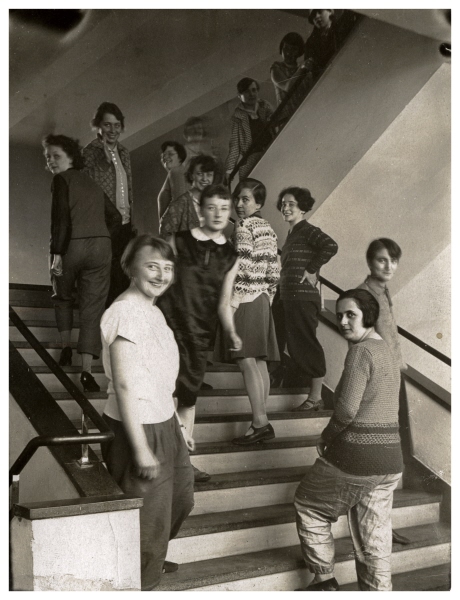
Could you tell us a little more about what interests you about the Bauhaus?
– First of all, I liked how the school was structured. I mean the actual teaching method: the fact that one had an artistic director and a workshop master for each department. The teaching, perhaps especially the first-year teaching, is very exciting. It was a kind of foundation year where they did many experiments, including in composition and color, which is enormous fun. You could play around and explore all the exciting and enjoyable things that art is based on. That’s something I recognize from my own studies at the National College of Art and Design, in Oslo, where they also had a preliminary year that was structured in a similar way to the Bauhaus, but not quite as playful. But I have to say, I am very happy with my own art education.
– In addition, I like the fact that they appointed Paul Klee as artistic director of the textile department. Of course, he didn’t know anything about textiles, but he learned a huge amount and you can see that in his pictures. In his striped paintings for instance, it’s clear that he’s been in the company of the textile women. He was also very interested in Armenian textiles and ecclesiastical art. And his way of working was transmitted to the students; it had a two-way effect.
– I think it’s fantastic that they all had the same preliminary training, and that the students in the textile department learned the same things as the students who, for example, wanted to become architects. It’s one thing to trust in the two-way effect that this brought about, but it also shows that they didn’t make the distinction that art historians are probably still being taught, that there are minor and important forms of art. We are still struggling with this idea that architecture, painting, and sculpture are the major forms of art, and that other art forms are perceived as minor, like textiles and other such material-based “nonsense,” are placed in a corner. It’s the same in music, the idea that country music is a minor form, something completely different from the major arts.
– But remember, the Bauhaus only lasted from 1919 to 1933, so they weren’t active for many years. Together with some Russian artists, who also emigrated to the U.S., they transformed the contemporary art scene. Think about how they interacted with and influenced each other – what a gang of amazing people! The fact that they were doing things together must have whipped up the atmosphere quite a bit, which is probably why what they made is so interesting.
– Because this is what we do – we always build while standing on the shoulders of others – we learn from others, we learn from history, and we learn from the people we meet. We are constantly learning; it’s fantastically enjoyable. That whole genius thing, that’s just nonsense.
***
Interview by Marte Danielsen Jølbo and Pernille Skar Nordby